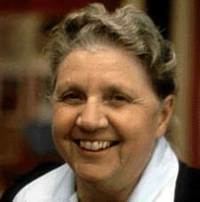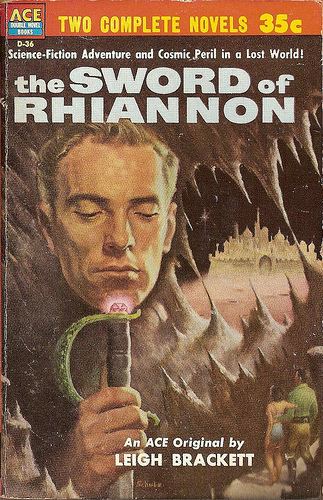Role Writer Name Leigh Brackett | Nationality American | |
 | ||
Born Leigh Douglass BrackettDecember 7, 1915Los Angeles, California, US ( 1915-12-07 ) Movies The Empire Strikes Back, The Big Sleep, Rio Bravo Awards Hugo Award for Best Dramatic Presentation, Cordwainer Smith Rediscovery Award, Spur Award for Best Novel Books The Long Tomorrow, The Sword of Rhiannon, The Ginger Star, Sea Kings of Mars and Other, The Secret of Sinharat Similar People | ||
Occupation Novelist, screenwriter | ||
Comic Book Art inspired by writer Leigh Brackett.
A World is Born by Leigh Brackett [SF Audiobook]
Leigh Douglass Brackett (December 7, 1915 – March 18, 1978) was an American writer, particularly of science fiction, and has been referred to as the Queen of Space Opera. She was also a screenwriter, known for her work on such films as The Big Sleep (1946), Rio Bravo (1959), The Long Goodbye (1973) and The Empire Strikes Back (1980). She was the first woman shortlisted for the Hugo Award.
Contents
- Comic Book Art inspired by writer Leigh Brackett
- A World is Born by Leigh Brackett SF Audiobook
- Life
- Fiction writer
- Bracketts Solar System
- Screenwriter
- The Empire Strikes Back
- References

Life

Leigh Brackett was born December 7, 1915 in Los Angeles, California, and grew up there. On December 31, 1946, at age 31, she married Edmond Hamilton in San Gabriel, California, and moved with him to Kinsman, Ohio. She died of cancer in 1978 in Lancaster, California.
Fiction writer

Brackett first published in her mid-twenties; the science fiction story "Martian Quest" appeared in the February 1940 issue of Astounding Science Fiction. Her earliest years as a writer (1940–42) were her most productive; occasional stories have social themes, such as "The Citadel of Lost Ships" (1943), which considers the effects on the native cultures of alien worlds of Earth's expanding trade empire.

Brackett's first novel, No Good from a Corpse, published in 1944, was a hard-boiled mystery novel in the tradition of Raymond Chandler (the book led to her first big screenwriting assignment) and Brackett's science fiction stories became more ambitious. Shadow Over Mars (1944) was her first novel-length science fiction story and though somewhat rough-edged, marked the beginning of a new style, strongly influenced by the characterization of the 1940s detective story and film noir.
In 1946, Brackett married fellow science fiction author Edmond Hamilton. Planet Stories published the novella "Lorelei of the Red Mist", in which the protagonist is a thief called Hugh Starke. Brackett finished the first half before turning it over to Ray Bradbury, so that she could leave to work on the movie The Big Sleep. Brackett returned to science fiction writing after her movie work, in 1948. From then on to 1951, she produced a series of science fiction adventure stories that were longer than her previous work, including classic representations of her planetary settings as "The Moon that Vanished" and the novel Sea-Kings of Mars (1949), later published as The Sword of Rhiannon, a vivid description of Mars before its oceans evaporated.
With "Queen of the Martian Catacombs" (1949), Brackett created Eric John Stark. Stark, an orphan from Earth, is raised by the semi-sentient aboriginals of Mercury, who are later killed by Earthmen. He is saved by a Terran official, who adopts Stark and becomes his mentor. When threatened, Stark reverts to the primitive N'Chaka, the "man without a tribe" that he was on Mercury. From 1949 to 1951, Stark (whose name echoes that of the hero in "Lorelei of the Red Mist") appeared in three tales, published in Planet Stories, "Queen of the Martian Catacombs", "Enchantress of Venus" and "Black Amazon of Mars". With this last story, Brackett's high adventure period of writing ended.
Brackett's stories adopted an elegiac tone, no longer celebrating the conflicts of frontier worlds but lamenting the passing of civilizations, concentrating more on mood than plot. The reflective, introspective nature of these stories is indicated in the titles: "The Last Days of Shandakor", "Shannach — the Last" and "Last Call from Sector 9G".
"Last Call" was published in the final issue (Summer 1955) of Planet Stories, always Brackett's most reliable market for science fiction. With the disappearance of Planet Stories and later in 1955, of Startling Stories and Thrilling Wonder Stories, the outlets for Brackett's stories closed and the first phase of her career as a science fiction author ended. Other stories trickled out over the next decade and old stories were revised and published as novels. A new production of this period was one of Brackett's most critically acclaimed science fiction novels, The Long Tomorrow (1955). This novel describes an agrarian, technophobic society that develops after a nuclear war.
Most of Brackett's writing after 1955 was for the more lucrative film and television markets. In 1963 and 1964, she briefly returned to her old Martian milieu with a pair of stories; "The Road to Sinharat" can be regarded as an affectionate farewell to the world of "Queen of the Martian Catacombs", while the other – with the intentionally ridiculous title of "Purple Priestess of the Mad Moon" – borders on parody.
She and her husband shared Guest of Honor duties at the 22nd World Science Fiction Convention in Oakland, California.
After another hiatus of nearly a decade, Brackett returned to science fiction in the seventies with the publication of The Ginger Star (1974), The Hounds of Skaith (1974) and The Reavers of Skaith (1976), collected as The Book of Skaith in 1976. This trilogy brought Eric John Stark back for adventures upon the extrasolar planet of Skaith (rather than his old haunts of Mars and Venus).
Brackett's Solar System
Often referred to as the "Queen of Space Opera", Brackett also wrote planetary romance. Almost all of her planetary romances take place in the Leigh Brackett Solar System, which contains richly detailed fictional versions of the consensus Mars and Venus of science fiction in the 1930s–1950s. Mars appears as a marginally habitable desert world, populated by ancient, decadent and mostly humanoid races; Venus as a primitive, wet jungle planet, occupied by vigorous, primitive tribes and reptilian monsters. Brackett's Skaith combines elements of her other worlds with fantasy elements.
Though the influence of Edgar Rice Burroughs is apparent in Brackett's Mars stories, her Mars is set firmly in a world of interplanetary commerce and competition. A prominent theme of her stories is the clash of planetary civilizations; the stories illustrate and criticize the effects of colonialism on civilizations which are either older or younger than those of the colonizers and thus they have remained relevant. Burroughs' heroes set out to remake entire worlds according to their own codes; Brackett's heroes (often antiheroes) are at the mercy of trends and movements far bigger than they are.
Screenwriter
Shortly after Brackett broke into science fiction writing, she wrote her first screenplays. Hollywood director Howard Hawks was so impressed by her novel No Good from a Corpse that he had his secretary call in "this guy Brackett" to help William Faulkner write the script for The Big Sleep (1946). The film was written by Brackett, William Faulkner and Jules Furthman, starring Humphrey Bogart and is considered one of the best movies ever made in the genre; after her marriage, Brackett took a long break from screenwriting.
When she returned to screenwriting in the mid-1950s, she wrote for TV and movies. Howard Hawks hired her to write or co-write several John Wayne pictures, including Rio Bravo (1959), Hatari! (1962), El Dorado (1966) and Rio Lobo (1970). Because of her background with The Big Sleep, Robert Altman hired her to adapt Raymond Chandler's novel The Long Goodbye for the screen.
The Empire Strikes Back
Brackett worked on the screenplay for the first Star Wars sequel The Empire Strikes Back. The film won the Hugo Award in 1981. This script was a departure for Brackett, since until then, all of her science fiction had been in the form of novels and short stories. Brackett's role in writing the script is disputed; George Lucas asked Brackett to write the screenplay based on his story outline. Brackett wrote a finished first draft which was delivered to Lucas shortly before her death from cancer on March 18, 1978. Two drafts of a new screenplay were written by Lucas and following the delivery of the screenplay for Raiders of the Lost Ark, turned over to Lawrence Kasdan for a new approach. Both Brackett and Kasdan (though not Lucas) were given credit for the final script.
Laurent Bouzereau, in Star Wars: The Annotated Screenplays, states that Lucas disliked the direction of Brackett's screenplay, discarded it and produced two screenplays before turning the results over to Kasdan. Some fans however believe that they can detect traces of Brackett's influence in the dialogue and the treatment of the space opera genre in Empire. Moreover io9's co-founder Charlie Jane Anders has written that while "It's fashionable to disparage Brackett's contributions to Empire", "it's not true that none of Brackett's storyline winds up in the final movie — the basic story beats are the same." Similarly John Saavedra of Den of Geek opines:
Most importantly, you see that Brackett's draft, while definitely in need of a rewrite and several tweaks, holds all of the big moments we'd eventually see on screen. We still get a version of the Battle of Hoth (a much more ridiculous one), the wise words of an old Jedi Master, the excitement of zooming through a deadly asteroid field, a love triangle (a MUCH more overt one), a majestic city in the clouds, unexpected betrayals, and the climactic duel between Luke Skywalker and Darth Vader that we would reenact on playgrounds for years to come.
Brackett's screenplay has never been officially or legally published. According to Stephen Haffner, it can be read at the Jack Williamson Special Collections library at Eastern New Mexico University in Portales, New Mexico (but may not be copied or checked out) and the archives at Lucasfilm in California. It is available on the internet as a PDF file.
